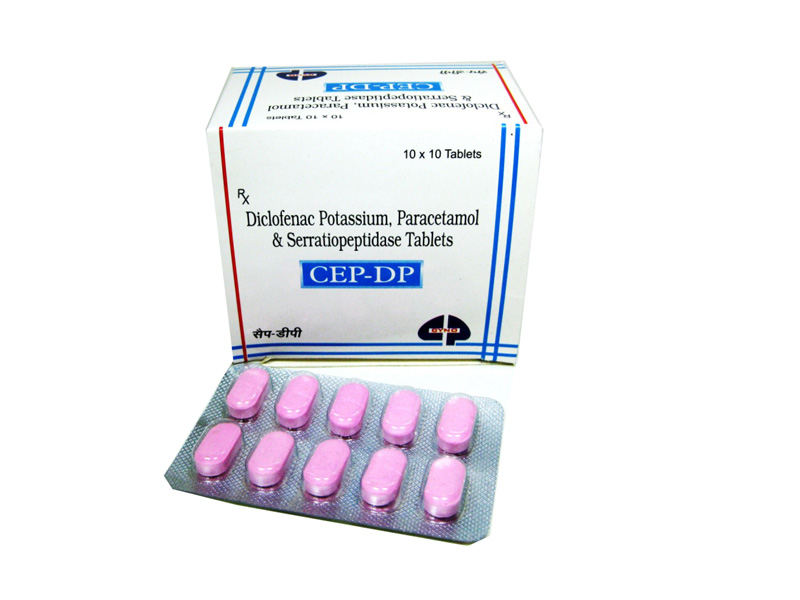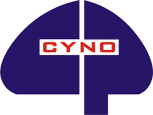CEP - DP
Diclofenac Potassium (50 mg), Paracetamol (325 mg), Serratiopeptidase (10 mg)
It is a pain-relieving medicine. It helps to reduce moderate pain ( muscle ache, joint pain, back pain, menstrual cramps, and toothache) and reducing fever, pain, swelling, and joint stiffness caused by arthritis. This medication is known as a nonsteroidal anti-inflammatory drug (NSAID).
Serratiopeptidase has properties like antiedemic, analgesic, fibrinolytic, and casinoolytic. It is a proteolytic enzyme that is used to reduce inflammation.
Paracetamol, also known as acetaminophen, is a drug used to treat pain and fever. It is commonly used for mild to moderate pain relief. Evidence is mixed for its use for relieving fever in children. It is often sold in combination with other drugs, as in many cold medicines.

Mechanism of Action
Serratiopeptidase is a proteolytic enzyme, which binds to alpha-2-macroglobulin in the blood, thereby, helps to mask its antigenicity but retain its enzymatic activity but retains and is slowly transferred to site of inflammation.
It reduces swelling and edema improves micro inoculation and accelerates the elimination of sputum by breaking down the liquifying mucus secretions and fibrin clots, hence it acts as anti-inflammatory anti edematous and anti-fibrinolytic. One of the useful actions of it is that it increases the concentration of antibiotic at the site of infection.
Paracetamol
Paracetamol is a non-steroidal anti-inflammatory drug and is a para-aminophenol derivative. It is a centrally acting analgesic and a potent antipyretic, but devoid of a significant anti-inflammatory effect which could be due to its weak activity on peripheral prostaglandin synthetase. This drug does not produce acid-base imbalance, electrolyte disturbances, and gastrointestinal irritation nor does it affect blood-clotting factors. It also posses uricosuric property to a varying degree and is non-addicting. Paracetamol is rapidly absorbed on oral administration.
Diclofenac potassium
Diclofenac potassium is a non-steroidal anti-inflammatory, analgesic, and antipyretic drug, which inhibits prostaglandin synthesis by interfering with the action of prostaglandin synthetase. It is ideally suited for patients on a sodium-free diet, hypertensive patients, and those on diuretic therapy.
Indications
- Analgesic and antipyretic postoperative and posttraumatic inflammations.
- Inflammatory edema and swelling.
- Inflammation in sinusitis.
- Muscular and skeletal pain co-existing associated conditions such as spondylitis.
- Rheumatoid arthritis and osteoarthritis engorgement of the breast.
- Painful inflammatory conditions in gynecology.
- Cystitis epididymitis pericoronitis of the wisdom tooth- third molar.
- Alveolar abscess inadequate expectoration such as in bronchitis, pulmonary tuberculosis.
Pharmacokinetic Properties:
Bioavailability – 100%; Protein – binding more than 99%; Metabolism – hepatic, no active metabolites exist; Half-life – 1.2-2 hr (35% of the drug enters enterohepatic recirculation); Excretion – biliary, only 1% in urine.
Drug-Drug interactions:
No drug interaction regarding CEP-DP is reported.
Precautions:
GI ulceration hematemesis melena ulcerative colitis and Crohn’s disease. Severe cardiac hepatic and renal impairment or insufficiency. The patient undergoing treatment with anticoagulants.
Breastfeeding: with caution
Fertility:
For those taking diclofenac, ovulation was reduced by an amazing 93%. The progesterone levels of women had also fallen.
Dosage:
Adult: One tablet of CEP-DP should be taken three times a day orally. It is advised not to take an empty stomach.
Duration of action:
The terminal half-life of unchanged diclofenac is approximately 2 hours.
Adverse Reaction:
In CEP-DP the adverse effects are gastrointestinal disturbances such as Anorexia, Nausea, and Gastric discomforts, Rashes, Rarely leucopenia.
Storage: Keep in a cool and dry place.
Overdosage:
Symptoms of an overdose may include severe abdominal pain, vomiting that looks like coffee grounds, excessive drowsiness, slow / shallow breathing, seizures.
Contraindications:
Hypersensitivity to the ingredients blood coagulation abnormalities peptic ulcer.Children-with caution
Warnings:
If you have an allergy to aspirin or other similar NSAIDs, such as ibuprofen or naproxen, you could have an allergic reaction to diclofenac. Call your doctor right away if you have any signs of:
- Wheezing
- Trouble breathing
- Hives
- Itchy rash
Pregnancy: with caution
Old age-with caution
